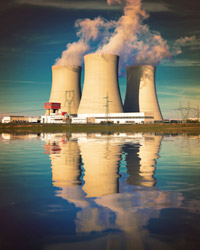Nuclear waste the focus of new £8m project

Image: ThinkStock
Academics at Loughborough University are part of an £8 million research programme looking at ways of dealing with Britain’s nuclear waste.
The national project, funded by the government’s Engineering & Physical Sciences Research Council (EPSRC), will start in February and brings together the nuclear industry, the Government’s nuclear advisors and the country’s leading academic researchers from 10 universities.
Over the next four years more than 40 doctoral and post-doctoral researchers will work on issues including how best to handle different types of spent fuels, packaging and storing waste, and dealing with nuclear sludges in ponds and silos at nuclear power stations.
The National Nuclear Laboratory (NNL), Nuclear Decommissioning Authority (NDA) and Sellafield Limited will be partners in the project, alongside project leaders the University of Leeds and the Universities of Birmingham, Bristol, Imperial, Lancaster, Loughborough, Manchester, Sheffield, Strathclyde and UCL.
At Loughborough, a team of 10 radiochemists and chemical engineers will work with academic partners to investigate corrosion of spent nuclear fuel in wet storage and to explore optimum ways of ‘cleaning’ water used to cool and store nuclear waste.
Innovative approaches include the development of a bespoke magnetic sampling process, and use of Time Resolved Laser Fluorescence Spectroscopy (TRLFS) - a technology that hasn’t previously been used in the UK.
Loughborough’s lead academic Dr Nick Evans said:
“Loughborough has a long history of nuclear research and we have been one of the leading universities in this area for the last 40 years. We are excited to be using new technologies and tailoring existing techniques to improve the management of nuclear waste. This project is truly collaborative and multi-disciplinary, involving some of the leading experts across engineering and the physical sciences.”
The project will be formally called Decommissioning, Immobilisation and Storage solutions for Nuclear waste Inventories (DISTINCTIVE) - and follows an earlier programme announced by the EPSRC in 2007, known as DIAMOND.
The EPSRC will provide a £4.9 million grant to the new project, with additional funding and support coming from the universities and the industry partners.
Research will be organised under four themes: AGR, Magnox and Exotic Spent Fuel; Plutonium oxide and Fuel Residues; Legacy Ponds and Silos Wastes; Infrastructure characterisation, restoration and preservation. Each project will have an industrial supervisor from either NNL or Sellafield Limited.
Much of the UK’s legacy waste is kept at the Sellafield site in Cumbria.
Sellafield Limited's Research Alliance Manager Neil Smart said: “Today, Sellafield faces a challenge where there is no blueprint; emptying and demolishing some of the most difficult and complex nuclear buildings in the world – the decommissioning of historic reactors, reprocessing facilities and associated legacy ponds and silos.
“This massive challenge is however an opportunity to demonstrate that Sellafield is still at the forefront of the UK’s nuclear industry and we are delighted that the EPSRC is supporting appropriate academic research that will contribute to the scientific and technical underpinning of our mission.
“We look forward to engaging in these projects and benefiting from the outcomes, not only in terms of the science and technology but also the skilled people developed through these projects with the potential to enhance our workforce long into the future.”
Graham Fairhall, Chief Science and Technology Officer at the NNL, which provides experts and technologies to government and the nuclear industry, also welcomed the project.
“Having 10 of the UK's leading universities working collaboratively with industry in this important area makes this a very significant programme,” he said. “We are pleased to be involved in a number of ways, including supervision of more than half of the projects and making the world-leading facilities in our central laboratory on the Sellafield site available to support several strands of the work.”
The NDA’s Head of Research and Development, Melanie Brownridge, said: “Our industry benefits hugely when high-level academic research is focused at some of the challenges we face in decommissioning our nuclear legacy. We welcome this collaboration and look forward to seeing the progress that these important projects will deliver. Equally valuable will be the development of knowledge and expertise for the participants – we hope their skills with be with us for many years ahead.”
−ENDS−